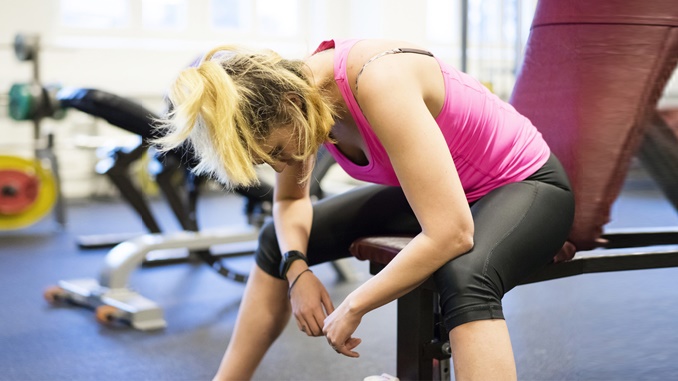
Chris had been devoted to his daily workouts for more than a month but, when he looked in the mirror, he had to admit he was disappointed. He just wasn’t seeing the results he’d hoped for. He wondered if he was doing something wrong or not working hard enough.
Tessa felt the same way. In her 40s, she’d started incorporating some strength training into her weekly routine to help make sure she didn’t lose muscle with age. However, after several weeks of doing so, she couldn’t see much of a difference in her muscles.
When we commit to a workout routine, we hope to see visible results. We want to look in the mirror and notice a difference and, if we don’t, we can become discouraged. That’s not good news as regular workouts are great for your health, energy levels, and long-term vitality, so the last thing you want to do is give up. Instead, let’s explore the 7 reasons your workouts aren’t working and how you can change things so that you start detecting more visible changes.”
1. You’re Not Working Out Enough
This one may be hard to hear, but it’s often the case, particularly if you haven’t been exercising for a while and you’re just getting back into it. Take an objective look at your workout schedule. If you’re hitting the gym only once a week or four to six times a month, you’re not going the see the results you want to see until you bump that up slightly.
How many times a week should you be working out? It depends on your fitness level, but a good average is three to four times a week. In a 2016 review, researchers looked at 10 studies that investigated resistance training only (not cardio) and found that training twice a week promoted superior outcomes to training only once a week.
Add to that the days that you do cardio, and you end up with at least four days of working out a week. If you’re not there yet, try increasing your workouts and see what happens.
2. You’re Working Out Too Much
On the other hand, more isn’t always better when it comes to how much you’re working out. Whereas about three to four times a week seems optimal, six times a week may hinder your progress more than help it, mostly because it doesn’t give your body the time it needs to recover between workouts. Overtraining can be one of the 7 reasons your workouts aren’t working.
In one recent study, researchers compared a weekly strength-training frequency of two times vs. four times in trained men. The found that though both training strategies improved performance and lower-body muscle mass, only those who trained twice a week increased upper body strength and composition.
In a 2016 study, scientists looked at the effects of strength training frequency on improvements in lean mass and strength in both men and women. They split the participants into two groups:
- Group 1 (“high-frequency” group): Trained three times per week, exercising with three sets of muscle groups per session.
- Group 2 (“low-frequency” group): Trained each muscle group one time per week, completing all nine sets during that one workout.
After eight weeks of training, results showed that both groups experienced similar improvements in lean mass and strength, showing that high frequency is not necessary, particularly with strength training.
When combining strength training and aerobic training, the results are similar. In 2013, researchers compared three different frequencies of training:
- Group 1 (1+ 1): Performed one day of aerobic training and one day of resistance training per week for a total of two days of workouts per week.
- Group 2 (2 + 2): Performed two days of aerobic training and two days of resistance training per week for a total of four days of workouts per week.
- Group 3 (3 + 3): Performed three days of aerobic training and three days of resistance training per week for a total of six days of workouts per week.
All activities included lifting weights and jogging or bike riding. Results showed that although all groups increased fat-free mass, strength and aerobic fitness while decreasing fat mass, only the 2 + 2 groups experienced an increase in total energy expenditure (total calories burned). Activity-related thermogenesis — the body’s ability to burn calories — also increased significantly in the 2 + 2 group and slightly in the 1 + 1 group, but decreased in the 3 + 3 group.
Researchers concluded that 3 + 3 training could have some negative effects on calorie burn and did not offer improvements over the other two training options.
So, examine your training routine and ask yourself — are you pushing it too hard?
3. You’re Doing the Same Workout Repeatedly
How long have you been going through the same workout routine? We can get comfortable with what we’re doing, but the problem is that the more you do the same types of workouts. The more your body will adapt, and the fewer results you’ll see. This can be one of the 7 reasons your workouts aren’t working.
The body is very efficient. The more you do the same type of activity, the more your body gets used to that activity until it builds up the muscles it needs and can complete the workout using less energy. This simple process is enough to frustrate many people as eventually. You will find that you’ve hit a wall and can’t break through.
A good rule of thumb is to change up your workout sessions about once a month. But it varies from person to person. The main thing is to watch your progress. If you stop seeing results, it’s time to switch things around.
That means you need to shock your body a little bit. Give it something new to do. Try adding more weight, increasing your reps, trying new moves, and engaging in a new type of cardio. If you’re doing standing barbell curls, switch to seated dumbbell curls. Instead of squats, move to lunges. Instead of jogging, try tennis or biking or take your jog to entirely new terrain, adding more incline. Try adding some periods of high intensity into your run, going full out for a minute before slowing down again.
Even small changes can make a big difference, so don’t feel like you have to do an overhaul of your fitness routine. Do something that makes your workout a little harder for a few days, which should be enough for you to start seeing results again.
4. You’re Doing Only Cardio Exercises
If you’re a runner, and you love running, you may reach a point where you no longer see results because you’re not doing any strength training. Cardio exercises can take you only so far, and then it’s time to start building up your muscles too.
Adding strength training to your routine helps boost your metabolism, and increase your strength so you can work out harder and faster and burn more calories. If you want to bulk up a little bit, strength training is critical to your workout as aerobic training supports mostly the lean muscle fibers that have the least potential for growth. Strength training also helps tone and shape your physique. So adding it to your routine is likely to help you get those visible results you’re seeking.
On top of that, studies have shown that strength training is good for your health, in that it supports heart health, helps control blood sugar levels, reduces the risk of osteoporosis, improves cognitive thinking, may help reduce the risk of dementia and helps boost self-esteem.
You can either combine strength training with your cardio workout or alternate days between the two. If you decide to combine them, be careful that you’re not overdoing it. If you move to cardio after hitting your muscles hard with strength training, you could tax yourself too much, which increases the risk of injury and may not give you the results you’re seeking.
5. You Haven’t Changed Your Diet
7 Reasons Your Workouts Aren’t Working. If you want to see changes in your body, but it’s unlikely that exercise alone will do it. Current research shows that while exercise is amazingly beneficial for your health in a number of ways, it’s unlikely to help you lose weight if you don’t combine it with a change in your diet. This can be one of the 7 reasons your workouts aren’t working. You may have heard the phrase, ‘You can’t out-exercise a bad diet. So make sure that you’re looking at both your workouts and your diet when planning a weight-loss program.
If you’re working out consistently, for example, but then you’re overeating or perhaps rewarding yourself with food, you will probably still gain weight. Take a good, hard look at the types of foods you’re eating. Cut back on processed items, refined grains, and sugary beverages and treats. If you’re already eating healthy, look at your portion sizes, and the time of day when you’re eating as later times are associated with greater risk of weight gain. Use a food journal to track your eating habits for a few weeks so that you can see exactly what’s happening.
Even if you’re not trying to lose weight but want to build up your muscles. You’ll probably need to change your diet to support your efforts, particularly by increasing your protein intake so that your body has what it needs to support new muscle development.
6. You’re Not Getting Enough Sleep
7 Reasons Your Workouts Aren’t Working. Research shows that we all need about seven to eight hours of sleep per night for optimal health. When you get less than that, or when your sleep is disrupted. Your hormones are affected, which results in you feeling hungrier the next day. These hormonal changes also cause you to crave carbohydrates and sweets.
Sleep deprivation is associated with increased levels of the stress hormone cortisol too, which is associated with weight gain as it tends to encourage the body to store more fat away. So, if you’re not getting enough sleep. You’re setting your body up for weight gain no matter how much you’re working out. Not only that but you’ll also hinder your body’s ability to develop muscle.
In a 2018 review of 18 studies, researchers examined data related to inadequate sleep, resistance exercise and performance. They found inadequate sleep impaired maximal muscle strength. In an earlier study, researchers found that participants with shorter sleep duration — less than six hours — had poorer muscle strength than those who slept for seven or eight hours.
“Good sleep is associated with greater muscle strength,” the researchers wrote, “while short sleep duration may be a risk factor for decreased muscle strength ….”
7. You’re Sitting the Rest of the Day
No matter how much you’re working out, if you’re sitting or remaining sedentary for most of the rest of the day, you’re likely to be disappointed with the results.
This can be frustrating if you work an office job or you happen to be at the computer for much of the day. You work out hard, but then you have to do your job. After a few weeks, you’re discouraged because your workouts don’t seem to be working.
The truth is that all that sitting can cancel out the effects of your exercise. In a 2017 review, scientists examined data from more than 40 studies and found that the more time we spend sitting — whether at the computer, in the car or on the couch — the greater our risk of premature death, heart disease, cancer and type 2 diabetes.
Another study showed that an hour workout a day didn’t undo the negative effects of sitting on insulin levels (related to diabetes) or blood fats (related to heart disease).
The solution is to find ways to move more throughout your day. You’ll burn more calories and help prevent the negative effects of sitting on the body and brain. Get up from your desk once every 30 minutes. Stand up when taking calls, take more short walks, take the stairs more often and keep a jump rope nearby and use it a couple of times a day.
Bike or walk to work if you can, switch between a sitting and standing desk throughout the day, and print out documents and pace while reviewing them rather than reviewing them on the screen. The more you can increase these types of small activities, the more results you’ll see from your exercise workouts too.
What we eat impacts the effectiveness of our workouts. For your guide to the best foods to slim your body, check out The Best Foods that Rapidly Slim & Heal in 7 Days, here!
.







